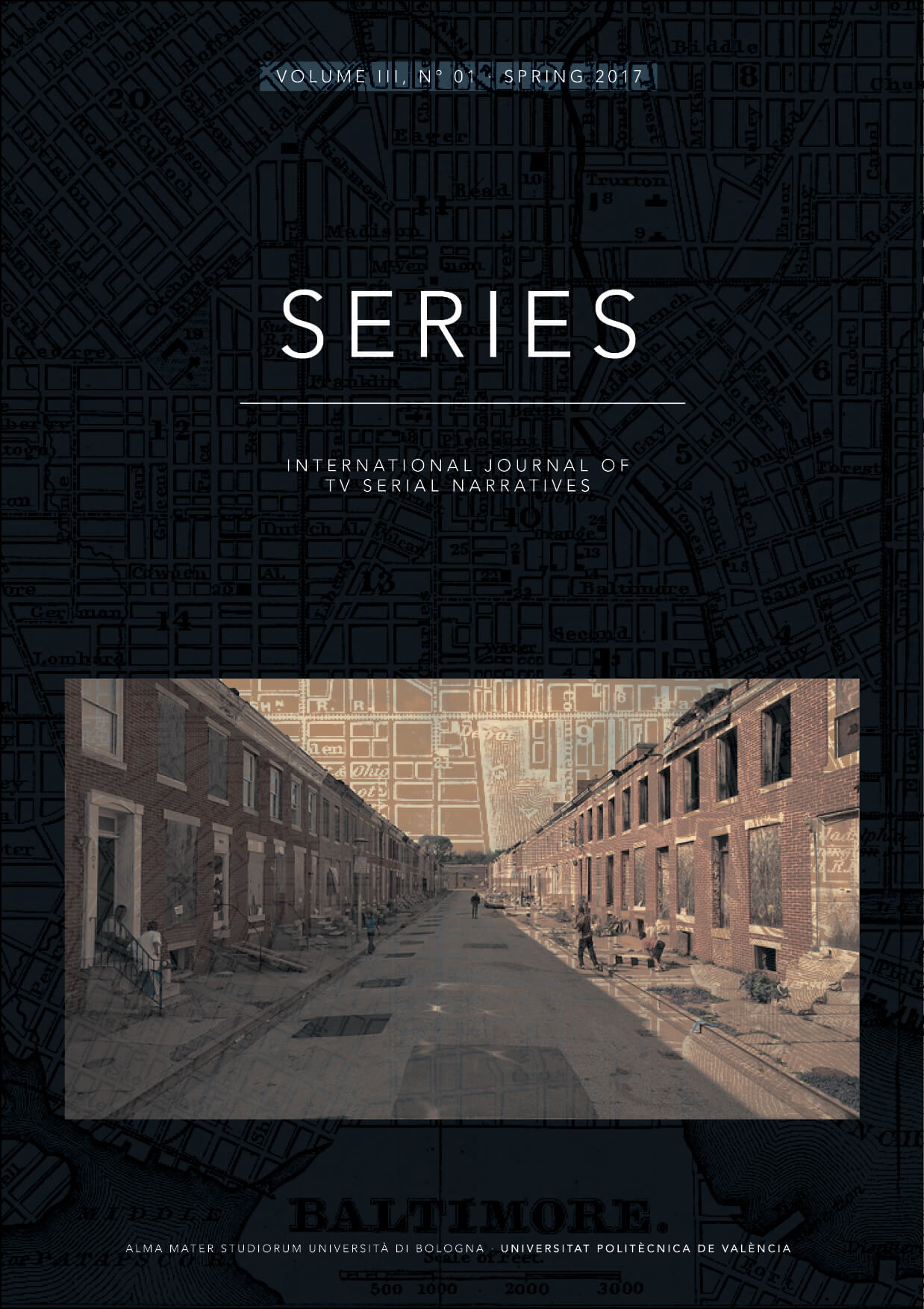Tilburg in Smeris: Local Audiences Engaging with (Familiar) Locations on National Television
DOI:
https://doi.org/10.6092/issn.2421-454X/7148Keywords:
local colour, audiences, location, place, televisionAbstract
When a city that is rarely featured on television is used in a television series, local audiences get enthusiastic. Locations featured on screen have particular cultural values to those living close to these television locations. This article expands on local audiences’ experiences by using a case study of the Dutch television series Smeris. Besides analysing the series and metadata, audience research, including Tweets and interviews, was conducted. While the first season of Smeris is set in Tilburg, the second season is mainly filmed in the capital Amsterdam. The normality of viewing Amsterdam on the screen is contrasted against the novel and special, yet familiar, experience of seeing Tilburg. Precisely because Tilburg is rarely featured on television, local audiences play with this physical place in relation to the place as featured on television. Local audiences may display their pride in this repositioning of Tilburg as a central figure. Locals may engage with the (mistakes within the used) mediated familiar locations. Moreover, residents may mix elements of reality (e.g. news articles) with events from the series. Thus, locals engage with this television series in for them new ways through mixing the places with their imagination.References
Adriaens, Fien and Daniel Biltereyst (2012). ‘Glocalized Telenovelas and National Identities: A “Textual Cum Production” Analysis of the “Telenovelle” Sara, the Flemish Adaptation of Yo soy Betty, la Fea.” Television & New Media 13(6): 551-67. DOI: http://dx.doi.org/10.1177/1527476411427926.
Agger, Gunhild (2016). “Nordic Noir – Location, Identity and Emotion.” In Emotions in Contemporary TV Series, edited by Alberto N. García, 134-52. London: Palgrave Macmillan.
Beeden, Alexandra and de Bruin, Joost (2010). “The Office: Articulations of National Identity in Television Format Adaptation.” Television & New Media 11(1): 3-19. DOI: http://dx.doi.org/10.1177/1527476409338197.
Beeton, Sue (2005). Film-induced Tourism. Clevedon: Channel View Publications.
Bignell, Jonathan (2017). “Cars, Places and Spaces in British Police Drama.” In Contemporary British Television Crime Drama: Cops on the Box, edited by Ruth McElroy, 123-36. London, Routledge.
Blandford, Steve and Lacey, Stephen (2011). “Screening Wales: Portrayal, Representation and Identity: A Case Study.” Critical Studies in Television 6(2): 1-12. DOI: http://dx.doi.org/10.7227/CST.6.2.3.
Blandford, Steve, Lacey, Stephen, McElroy, Ruth and Williams, Rebecca (2010) “Screening the Nation: Landmark Television in Wales”. Report for BBC Audience Council Wales. http://culture.research.glam.ac.uk/documents/download/13/ (last accessed 05–07–17).
Bollhöfer, Björn (2007). “‘Screenscapes’: Placing TV series in their contexts of production, meaning and consumption.” Tijdschrift voor economische en sociale geografie 98(2): 165-75. DOI: http://dx.doi.org/10.1111/j.1467-9663.2007.00389.x.
Buschow, Christopher, Schneider, Beate and Simon Ueberheide (2014). “Tweeting television: Exploring communication activities on Twitter while wacthing TV.” Communications 39(2): 129-49. DOI: http://dx.doi.org/10.1515/commun-2014-0009.
Castelló, Enric (2009). “The Nation as a Political Stage: A Theoretical Approach to Television Fiction and National Identities.” International Communication Gazette 71(4): 303-20. DOI: http://dx.doi.org/10.1177/1748048509102183.
Castelló, Enric (2010). “Dramatizing proximity: Cultural and social discourses in soap operas from production to reception.” European Journal of Cultural Studies 13(2): 207-23. DOI: http://dx.doi.org/10.1177/1367549409352274.
Castelló, Enric, Nichola Dobson and Hugh O’Donnell (2009). “Telling it like it is? Social and Linguistic Realism in Scottish and Catalan Soaps.” Media, Culture & Society 31(3): 467-84. DOI: http://dx.doi.org/ 10.1177/0163443709102718.
Dhoest, Alexander (2007). “The National Everyday in Contemporary European Television Fiction: the Flemish Case.” Critical Studies in Television: The International Journal of Television Studies 2(2): 60-76. DOI: http://dx.doi.org/10.7227/CST.2.2.7.
Eichner, Susanne and Anne Marit Waade (2015). “Local Colour in German and Danish Television Drama: Tatort and Bron//Broen.” Global Media Journal. German edition. 5(1): 1-20.
García Avis, Isadora (2015). “Adapting Landscape and Place in Transcultural Remakes: The Case of Bron|Broen, The Bridge and The Tunnel.” SERIES – International Jouranl of TV Serial Narratives 1(2): 127-38. DOI: http://dx.doi.org/10.6092/issn.2421-454X/5898.
Griffiths, Merris (2009). “Small Town on the Big Screen: The Edge of Love and the Local Experience.” Participations 6(2): 403-430.
Haenen, Marcel (2014) “Tilburg Wietstad.” NRC Handelsblad. https://www.nrc.nl/nieuws/2014/01/25/tilburg-wietstad-1338670-a625678 (last accessed 15-07-16).
Harrington, Stephen, Tim Highfield and Axel Bruns (2013). “More than a Backchannel: Twitter and Television.” Participations 10(1): 405-9.
Hawksey, Martin (2013). Twitter Archiving Google Spreadsheet (TAGS). https://tags.hawksey.info/get-tags/ (last accessed 05–07–17).
Kuijpers, Pieter (2014). Tilburg Wietstad?. Tilburg: Night University. (1-10-14).
Lacey, Stephen (2013). “‘When you see Cardiff on Film, it looks like LA’ (John Barrowman): Space, Genre and Realism in Torchwood.” In Torchwood Declassified: Investigating Mainstream Cult Television, edited by Rebecca Williams, 137-53. London: I.B. Tauris.
McElroy, Ruth (2017). “Introduction.” In Contemporary British Television Crime Drama: Cops on the Box, edited by Ruth McElroy, 1-24. London, Routledge.
McElroy, Ruth and Caitriona Noonan (2016). “Television Drama Production in Small Nations: Mobilities in an Changing Ecology.” Journal of Popular Television 4(1): 109-27. DOI: http://dx.doi.org/10.1386/jptv.4.1.109_1.
Mills, Brett (2008). “My house was on Torchwood!: Media, Place and Identity.” International Journal of Cultural Studies 11(4): 379-99. DOI: http://dx.doi.org/10.1177/1367877908096002.
Murphy, J. J. (2014). “Where are you from? Place as a form of scripting in independent cinema.” Journal of Screenwriting 5(1): 27-45. DOI: http://dx.doi.org/10.1386/josc.5.1.27_1.
Reijnders, Stijn (2011). Places of the imagination: media, tourism, culture. Farnham, England: Ashgate.
Stichting KijkOnderzoek (2015). KijkTotaal Smeris. Amsterdam: Stichting KijkOnderzoek.
Straubhaar, Joseph D. (1991). “Beyond media imperialism: Assymetrical interdependence and cultural proximity.” Critical Studies in Mass Communication 8(1): 39-59. DOI: http://dx.doi.org/10.1080/15295039109366779.
Turnbull, Sue (2015). “Trafficking in TV crime: remaking Broadchurch.” Continuum 29(5): 706-17. DOI: http://dx.doi.org/10.1080/10304312.2015.1068731.
Willems, Niek (2014). “Tilburg op je beeldscherm.” Quats (9): 9-12. Tilburg: Bureau Zuid.
TV Series and Films Cited
Doctor Who (2005 - )
Smeris (2014 - )
The Edge of Love (2008)
Torchwood (2006-2011)
Downloads
Published
How to Cite
Issue
Section
License
Copyright (c) 2017 Sandra Wagemakers
Copyrights and publishing rights of all the texts on this journal belong to the respective authors without restrictions.
This journal is licensed under a Creative Commons Attribution 4.0 International License (full legal code).
See also our Open Access Policy.





